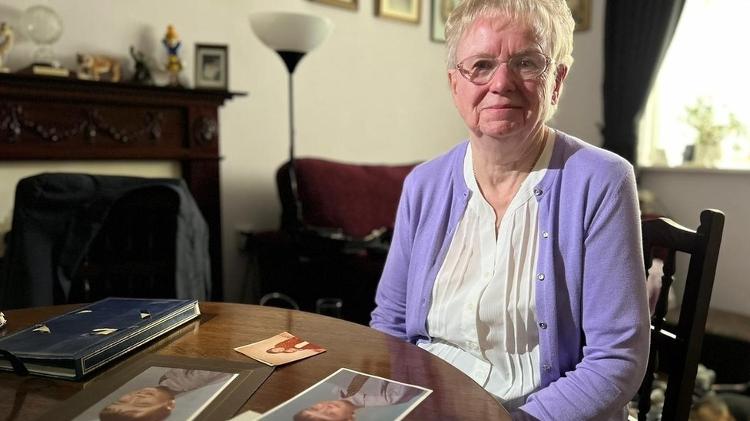At least 175 children with hemophilia, a blood disease, were infected with HIV in the 1970s and 1980s, according to documents from UK national archives analyzed by BBC News.
Some of the families affected are testifying in what has been called the “worst treatment disaster in NHS history”.
It happened almost 36 years ago – in late October 1986 – but Linda* will never forget the day she found out her son was infected with HIV.
She was summoned to an office at Birmingham Children’s Hospital along with 16-year-old Michael.
As a child, he was diagnosed with hemophilia, a genetic disease that prevents blood from clotting properly.
Linda had assumed the meeting was to discuss moving treatment to a new location, Queen Elizabeth Hospital.
“It was such a routine thing that my husband stayed outside in the car,” she recalls.
“Then all of a sudden the doctor said, ‘Of course, Michael is HIV positive.'”
“He conveyed the truth as if he were talking about the weather outside. I was sick to my stomach.”
“We got in the car, I told my husband, and we were quiet until we got home. It was a shock.”
positive test
The episode took place at the beginning of the AIDS crisis, but the stigma of the disease was already very real.
In 1985, dozens of parents took their child after a nine-year-old from a primary school in Hampshire, also in the UK. Also hemophilia? HIV test was positive.
Michael did not want his friends or family to be made aware of the diagnosis.
“This is how she got it done: keeping it to herself,” Linda says.
“She never told her friends or anyone else because she just wanted to feel normal.”
Between 1970 and 1991, 1,200 people with hemophilia in England became infected with HIV after taking Factor 8 – a new treatment that replaced the clotting protein that was then missing in the blood of people with the disease.
Now, documents from the UK’s National Archives reveal that among these patients, there are at least 175 children who received the drug in hospitals and hemophilia clinics of the British public health service, the NHS.
Tens of thousands of people are believed to have suffered hepatitis C, a viral disease that can cause liver failure and cancer through the same treatment or blood transfusion.
About half of people infected with HIV died before antiretroviral drugs were made available to the public.
drug users
Forty years ago, the UK was not self-sufficient in blood-based medicines, so Factor 8 was imported from the USA.
Each treatment batch is made from pooled or pooled blood plasma from thousands of donors.
If only one of these donors was HIV positive, the virus could be in the therapy formulation.
Pharmaceutical companies in the US paid individuals to donate blood, including groups considered at the time to be at high risk for HIV infection, such as inmates and drug users.
Linda remembers first hearing about AIDS during a presentation at Birmingham Children’s Hospital in 1984. She remembers being alert and alert to certain symptoms described.
But she says the family was never fully aware of the dangers involved—a nurse once said that Linda didn’t need to worry because “Michael was fine.”
All this time, the son continued to be treated with the same drug of American origin.
In his late adolescence, Michael began to experience health problems, from night sweats and fever to swollen glands and flu bouts.
But he continued to live life to the fullest: traveling, listening to music and supporting West Bromwich Albion football club.
“There was a big game at Wembley Stadium and it was in really bad shape,” says Linda.
“So we decorated the whole car and he found his friends. No matter how he felt. If he could go to the stadium, he would.”
Years later, when Michael’s immune system began to show more serious problems, he lost a lot of weight, was very tired, and lost some of his memory.
She was transferred to Heartlands Hospital in Birmingham, where Linda, who quit her job as a nursing home cook, helped care for her for the last few months of her life.
He said to me, ‘Mom, you’re never going to be a babysitter.
“Don’t worry” I replied.
“It was all I could think of to say,” Linda says.
Michael developed meningitis and pneumonia, both related to the HIV virus he had contracted as a child.
He died on May 26, 1995, exactly one week before his 26th birthday.
private session
Nearly three decades later, Linda provides evidence and testimony for a long-running public inquiry into the haemophilia treatment disaster in the British public health system.
He will take part with other parents in a special session on the experiences of families with HIV-infected children in the 1970s and 1980s.
“I felt compelled to do this because I want to help decipher this story,” he says.
“We all want to know why they let this happen and continue to affect so many people.”
* Linda requested that her last name be withheld..
– This text was published at https://www.bbc.com/portuguese/internacional-63156989.
source: Noticias
